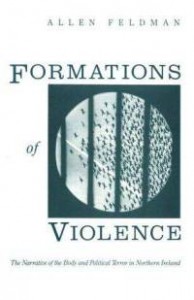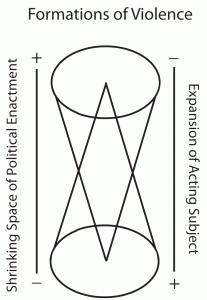Feldman, Allen. 1991. Formations of Violence: The Narrative of the Body and Political Terror in Northern Ireland. Chicago: University of Chicago Press.
Formations of Violence came highly recommended, and I was not disappointed. The overly dense theoretical introduction and Allen Feldman’s overly complex writing style made me skeptical at first, but the material and the argument kept me engaged throughout the book. Feldman examines 1970s political violence in Northern Ireland through the narrative of the body, but more than a “mere” lens, he argues that the body itself became a prime site and weapon for the deacade’s violent interactions. The account is also deeply spatial: “Wherever encountered in the book, the shrinkage of the space of political enactment corresponds to the expansion of the acting subject—the increasing correlation of personhood to historical transformation” (10). The book traverses—by chapter—various spaces: the city, the neighborhood, the jail, the jail cell, the body of the hungerstriker, and at each scale of spatial framing the body is shown to be a pivotal political agent; political violence achieves and works through the “instrumental staging and commodification of the body” (9).
Oral history is the research method and mode of exposition that Feldman chooses for presenting the story and his arguments. But more than this, the narrativity that oral history exemplifies is the condition for how people process the “identification of events, agents, and mediating sequence. Event, agency, and narration form a ‘narrative bloc’ (Lyotard 1973: 268) defined as the achronic engenderment of narrative, agency (narration), and event. Narrative blocs are plastic organizations involving language, material artifacts and relation” (14). In justifying his politics of narration, Feldman, in a footnote, writes: “A good deal of the ‘new ethnography’ discourse is concerned with the recuperation of presences as embodied by the fieldwork encounter (which is a naïve reading of this encounter. The discourse reads the textualization process as an analogue of the Marxist theory of alienation, where the producer (the informant) is alienated from his product (discourse) by the ethnography” (284).
The deepening sectarian segregation of Belfast created tense “interface” zones between religiously identified communities. Parades and processions that spilled into riots—and more overt forms of violence—became one way that militants purposefully transgressed these borders and the physical walls enforcing the borders. In the process they extended the borders and redefined them. “Crowd violence colonized and inscribed anomalous social space with sectarian codes. In this dynamic, topography ceased to function as a thing. It was much more than a passive template for the inscription of violence or and object to be manipulated in order to create political representations. Space became a power and an animated entity” (28). “Not all the violence of this period was limited to the mixed communities and other interface zone, but the spatial retrenchment reorganized the political-sectarian topography of Belfast—a process that generated certain preconditions for the autonomous reproduction of violent reciprocity” (35).
 Space and the body become an indivisible circuitry throughout the chapters. When discussing the shifts from “hardmen” to “gunmen” experienced in various neighborhoods, Feldman remarks, “The convergence of body space and topographic space is also a crucial component in telling. The proper reading of the various signs of embodiment, including dress, insignia, and speech create a circuit that indicate residential affiliation of the subject and his precise relationship or nonrelationship to the social space in which the subject is encountered” (58). Gunmen, for instance, would go into opposing neighborhoods to take out their targets wearing the identifiable clothing of their victims social groups. Funerals are another example of the richness of social spaces in war-torn Belfast, particularly around spatial-personal genealogies of the dead: “The genealogies are calendrical markers that anchor overarching events of historical magnitude in local temporalities and representations. The community marks itself with the cartography of death events—the space of the dead. Local history, biography, and topography intertwine through the network of genealogy” (65). The mechanics of this process speak to the ricocheting power of political terror: “that terror has its own circuits of amplification that do not require material destruction on a large scale, is an essential discovery of paramilitary practice” (79). The pervasiveness of violence took on an effect of white noise: “This is the backgrounding of violence, that is, the emergence of violence as the assumed basis of entire domains of social interaction and of the informal ideologies of everyday life” (110).
Space and the body become an indivisible circuitry throughout the chapters. When discussing the shifts from “hardmen” to “gunmen” experienced in various neighborhoods, Feldman remarks, “The convergence of body space and topographic space is also a crucial component in telling. The proper reading of the various signs of embodiment, including dress, insignia, and speech create a circuit that indicate residential affiliation of the subject and his precise relationship or nonrelationship to the social space in which the subject is encountered” (58). Gunmen, for instance, would go into opposing neighborhoods to take out their targets wearing the identifiable clothing of their victims social groups. Funerals are another example of the richness of social spaces in war-torn Belfast, particularly around spatial-personal genealogies of the dead: “The genealogies are calendrical markers that anchor overarching events of historical magnitude in local temporalities and representations. The community marks itself with the cartography of death events—the space of the dead. Local history, biography, and topography intertwine through the network of genealogy” (65). The mechanics of this process speak to the ricocheting power of political terror: “that terror has its own circuits of amplification that do not require material destruction on a large scale, is an essential discovery of paramilitary practice” (79). The pervasiveness of violence took on an effect of white noise: “This is the backgrounding of violence, that is, the emergence of violence as the assumed basis of entire domains of social interaction and of the informal ideologies of everyday life” (110).
The state, too, works within such logic, and Feldman traces this process in examining arrest and interrogation, along with other spectacular forms of state performance (raids and such). “Predawn arrests are spectacles that elicit subject positions by commanding complicitous silence and passivity. The predawn house raid by the counterinsurgency forces is a display of colonizing power and the command of territory; it reclaims a temporality and geography of subversion” (89). Intrusion and assassination at the home became a particularly terrifying instrument in their ability to transgress particularly closely held cultural constructions of the home as a sanctuary space. State forces arresting someone at their home was also a way of isolating that “compromised” family and the space of their home from the broader community, a socio-spatial cordon sanitaire.
The prison and the interrogation room embody the state as a site of power: “In a single self-constituting rush of violence, seeming to emerge from the very architecture of coercion itself and establishing its dominance in a total immediacy that distributes all the participants of the interrogation into their appropriate spatial, political, and historical positions” (128). The body itself attains an expressed ambiguity: “Either the body was extended by the technology of weaponry in the military operation or it was extended into a weapon of interrogation center of the prison” (143).
The person being interrogated is not, however, powerless. Feldman provides accounts of prisoners who managed to tactically reverse the power imbalance of the interrogation. In these latter chapters, beginning with the interrogation and following up with the prison insubordinations of the blanket and dirty protests, Feldman’s point about the shrinking of space being accompanied by an expanded historical exertion of personhood begins to come through stronger and stronger, culminating with the tragic hunger strike in 1981. The prison itself became a central node of counterinsurgency strategies, and the prisoners responded via their own “insurgent” practices within the prison walls. In the end, they hoped that their hunger strike as a kind of prison foquismo would help incite more popular insurrection outside its walls.
Feldman shows how the culminating hunger strike was the product of a long and patient political construction within the prison. The prisoners scoffed at the suggestion of their practices as “mere” protest; they recognized it implied an entire way of life defined by the prison strictures: “There was no reality outside the various systems and countersystems of representations and objectification that were violently hurled back and forth through the recesses of the prison. The capacity to symbolize and encode a given reality was the basis of political resistance” (165). The politics of shit and their refusal to where the standard prison stripes were two main fonts of counter-conduct. In place of stripes, the prisoners chose to wear the blankets, refusing their branding as common criminals.
“The Blanketmen’s subsequent strategies of resistance were predicated upon the anomalous structuration of their bodies in prison. The naked body and its biology, which had suddenly become a passive source of defilement and coercion with the new levels of harassment and violence, had to be reinvented as an actively defiling and therefore power-laden agency, thus restoring the political potency of the prisoners” (181). At times, this meant living in their own shit, using their necessary bodily functions as a way of inflicting (bodily) political pressure on their captors. “The most crucial dynamic of this process was the causal relation established between ideological development and new reorganizations of the human body. Each stage of politicization and ideological attainment corresponded to a radical deconstruction and reassemblage of the body” (204)—think: torture and interrogation to the politics of shit, the blankets, and the anal mirror searches. Prisoners used various parts of their bodies to smuggle and hide messages and critical illicit supplies—noses, bellybuttons, penis foreskin, anal cavities, mouths.
In the case of ordering hits on prison guards outside of the jail and the hunger strike, their political actions also sought to exceed the “structures of confinement” (198). The also began Gaeilic classes in the run up to the hunger strike, reserving a space on their shit-covered walls for writing.
The cell became a historical membrane that secreted a record of prison experience and knowledge…. It had become an archaeological artifact, a place for the storage and the liberation of memory. An entire genealogy of resistance was etched with pain and endurance into the material of imprisonment. Both the mind and the bodies of the prisoners passed into this cell membrane through the media of their writing and the fecal transcription of their political condition. (217)
The final chapter recounts the 1981 Hunger Strike. The Blanketmen viewed the strike as “a military campaign and organized it as such. For them, it was a modality of insurrectionary violence in which they deployed their bodies as weapons. They fully expected a coupling of this act of self-directed violence with mass insurrectionary violence outside the prison” (220)—prison foquismo. The logic was at least partly based on the corpse as an equivalent ideological and tactical “unit of political communication,” whether that corpse is the product of a bombing or a self-inflicted, sacrificial death (232).
After 217 days, ten prisoners had died in their hospital beds.


Pingback: Aretxaga: Shattering Silence | Territorial Masquerades
Pingback: Geographies of the Outlaw | Territorial Masquerades